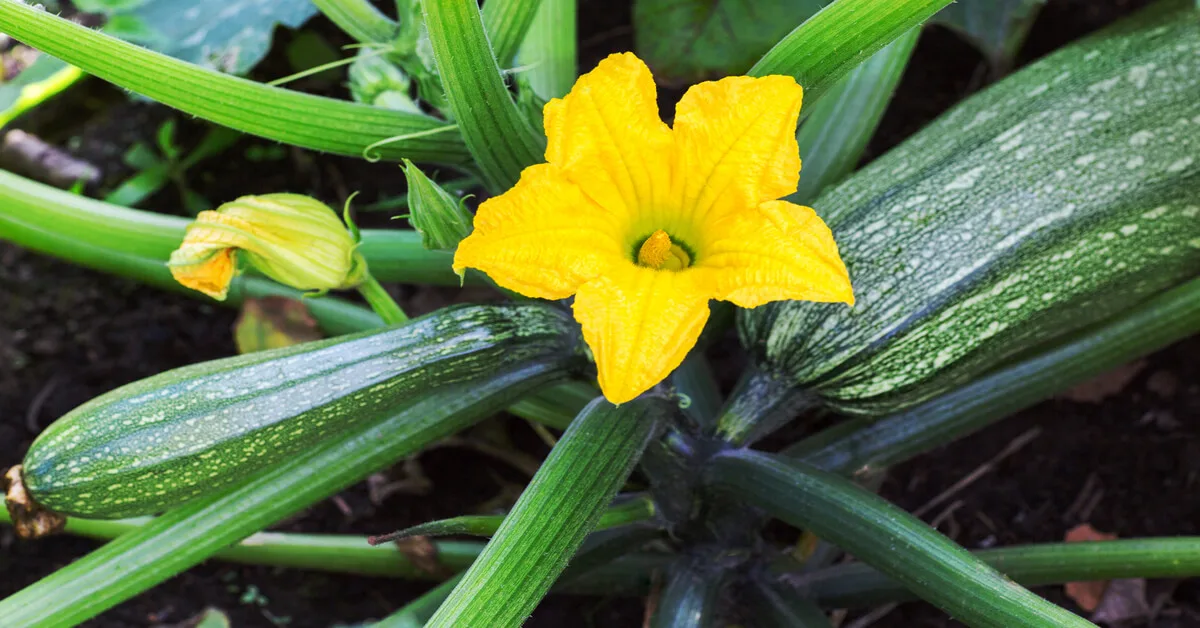Some of the links in this post are affiliate links. This means if you click on the link and purchase the item, I will receive an affiliate commission at no extra cost to you.
Zucchini (Cucurbita pepo) is a specific variety of summer squash. This annual, herbaceous plant is a member of the gourd family (Cucurbitaceae).
Zucchini plants live from 90 to about 150 days depending on the climate. Bush varieties can reach a size of 3.5 feet tall and up to 4 feet wide. Vining varieties can grow from 6 to 10 feet long. How long zucchini live and how big they get also depends on the variety planted.
While zucchini is referred to as vegetables in the kitchen, they are actually fruits. Botanically speaking, zucchini is a pepo which is a berry with a hardened skin known as the epicarp. Keep reading to learn everything about how to plant and grow zucchini.
History Of Zucchini
Zucchini originated in the Americas. The first known description of zucchini was made by Charles Naudin in 1856. This zucchini variety was called Larnaca. It was described as having light-colored, cylindrical fruit.
The first dark green zucchini variety described was in 1901 by Domenico Tamaro. The first commercially available seeds for zucchini were produced in North America in 1921.
Zucchini Plant Care

Zucchini plants are easy to tend to and relatively low maintenance. The most important thing to provide is fertilizer, water, and sunlight.
You’ll want to wait until the soil is warm to plant zucchini. Also, keep an eye out for insect pests and diseases. Below is everything you need to know to grow zucchini.
Soil
Zucchini plants grow best in soil that is well drained but also retains moisture. Adding organic matter to sandy soils will help with moisture retention. Adding organic matter to clayey soil will help with drainage.
The optimal soil pH is 6.0 to 6.5. However, zucchini can grow in soils with a pH of up to 7.0. It’s a good idea to plant in raised beds to allow for extra drainage.
Watering
Zucchini needs 1 inch of water per week while growing. Vining plants on a trellis will need more water. Make sure to water the soil deeply when watering. Avoid getting the leaves wet when watering to prevent disease.
Lighting
Provide at least 6 hours of direct sunlight per day for optimal zucchini growth. The morning sunlight is best.
Humidity & Temperature
Optimal humidity for zucchini is 40% to 70%. High humidity can lead to disease development. It can also cause increased vegetative growth and decreased fruit production.
Plant zucchini plant when temperatures are 70 to 90 degrees Fahrenheit. Zucchini is a warm-season crop and doesn’t do well when soil temperatures are below 60 degrees Fahrenheit.
Fertilizing
Incorporate a 10-10-10 granular fertilizer into the top 2 to 4 inches of soil before planting. Apply 2 lbs for every 1000 square feet of planting. This is equal to about ⅓ cup of 10-10-10 granular fertilizer per 100 square feet.
Once flowers begin to appear, you should side-dress the plants with fertilizer. Use 1 cup of 27-3-3 for every 100 feet you have planted with zucchini. Spread the fertilizer evenly around plants and keep it from touching the stem.
Diseases & Pests
There are several plant diseases and insect pests which can impact zucchini plants. Growing zucchini under optimal conditions will reduce disease issues. Frequently checking for insect damage will allow you to stop them before significant damage occurs.
Diseases to watch for are angular leaf spot, anthracnose, Choanephora rot, cucumber mosaic virus, powdery mildew, squash mosaic virus, watermelon mosaic virus, and zucchini yellow mosaic virus.
Insects to watch for include spotted cucumber beetles, squash bugs, squash vine borers, and striped cucumber beetles.
Days To Maturity
Most zucchini varieties will produce mature fruit within 40 to 60 days after seeds are planted. Fruit maturation may be slower if growing conditions aren’t ideal.
Harvesting

Zucchini should be harvested before they are fully grown and the skin becomes too tough. It is best to harvest the fruit when it is 6 to 8 inches long and 2 to 3 inches around.
Zucchini plants have spines unless you plant a spineless variety. These can irritate your skin. Wear long sleeves and gloves when harvesting fruit.
Use a sharp, clean tool to remove the zucchini from the plant. Store them in the fridge for up to 10 days. You can also blanch zucchini and then store it in the freezer for up to 3 months.
All members of the Cucurbit family produce defensive chemicals known as cucurbitacins. Some cucurbits have more of these chemicals than others to deter animals from eating them.
At high levels, cucurbitacins can cause digestive issues like stomach cramps and diarrhea. High levels of cucurbitacins also cause the fruit or vegetable to taste bitter.
Edible cucurbits, like zucchini, have been bred over time to produce fewer cucurbitacins. This makes them safe to eat. In rare cases, zucchini plants can produce bitter zucchini high in cucurbitacins. If you bite into a bitter zucchini, you should throw it out to avoid any digestive discomfort it could cause.
How To Plant Zucchini

It is important to know when to plant zucchini. The best time to plant depends on where you live. Plant zucchini when soils reach an average temperature of 70 degrees Fahrenheit. You can directly sow seeds into the ground once the soil is warm enough.
Transplanting is usually not recommended for zucchini. Temperature changes they experience when moved outside can kill transplants. They also don’t tolerate their roots being disturbed well. Since they produce fruit in as little as 40 days, starting seeds indoors isn’t necessary.
Sow seeds into soil that has been tilled and the appropriate fertilizer has been added. If you’re planting a vining variety, you’ll need to consider how to support your zucchini plants. They are easiest to support with a simple trellis. Install the trellis before planting your seeds.
Plant seeds about one inch deep and 2 to 3 inches apart along a row. Once seedlings emerge, thin them out leaving only the healthiest seedlings. The ideal zucchini plant spacing is 8 to 12 inches between plants and 2 to 3 feet between rows.
You can also plant zucchini in groups on a mound of soil. Plant 3 or 4 seeds per mound and leave at least 5 feet between each mound.
If you want to produce zucchini for longer, use succession planting. Plant half of your plants at the beginning of the growing season. Wait three weeks to plant the remaining zucchini. This will prevent all of the zucchini from maturing at a single time prolonging the harvest period.
To help maintain zucchini plants, add a layer of mulch over the soil. This will help retain moisture and reduce weed growth.
Zucchini Pollination

Poor pollination is the most common reason zucchini fruit doesn’t reach maturity. Increase pollinators by planting flowers and reducing pesticide use. You can also use a paintbrush to hand-pollinate flowers to ensure good pollination.
Hand-pollination works best in the morning on newly opened flowers. Male flowers have shorter stems than female flowers. You will see their pollen-covered stamens in the center.
Gently collect the pollen from the stamen of the male flower on the end of a soft paintbrush. Then rub the pollen on the stigma at the center of the female flower. The female flower is now pollinated.
Zucchini Plant Stages
There are 5 zucchini growing stages. The first is the germination stage which begins with the zucchini seeds being planted. Depending on the soil temperature, the seed will germinate in 7 to 10 days.
Once the zucchini plant emerges, it will produce two cotyledons. The cotyledons are embryonic leaves that were already formed inside the seed. Soon after, the first pair of true leaves will form and the seedling stage begins.
During the seedling stage, zucchini plants will develop more roots than leaves. The plant requires enough roots to provide water and nutrients to the zucchini plant leaves. Once it has enough roots and about 5 to 7 true leaves, the vegetative growth stage begins.
The plant grows more leaves and stems during the vegetative growth stage. The leaves allow for more photosynthesis which produces energy for flower development. The stems grow to provide structure to support the fruits. This stage lasts for several weeks.
Once the zucchini plant is large enough, it begins the flowering stage. Zucchini have both male and female flowers which require insect pollination to produce fruit. The flowers are only open for a few days.
Once pollination occurs, the maturation stage begins. Zucchini only take about a week to develop after being pollinated. Mature zucchini should be harvested and eaten within a week for the best taste.
Types Of Zucchini
There are scores of different zucchini varieties. Some varieties grow as vines while others form compact bushes. Depending on the variety, the fruits can be cylindrical, round, green, or yellow. There are also spineless varieties and disease-resistant varieties.
The table below lists some of the most popular varieties of zucchini. It also outlines their unique characteristics and days to maturity.
| Variety | Characteristics | Days to Harvest |
| Black Beauty | Bush variety with dark green fruits and few to no seeds | 44-64 |
| Easy Pick Gold II | Spineless bush variety with golden fruits | 48 |
| Geode | Bush variety with round, light-green fruits | 49 |
| Green Machine | Bush variety that is resistant to most diseases | 45 |
| Raven | Nearly spineless, semi-vining variety | 48 |
| Sungreen | Compact bush variety, great for small spaces, resistant to viruses | 51-60 |
| Thunderbird | Vining variety, resistant to most diseases | 63 |
Zucchini Companion Plants
The most notable companion planting method for zucchini is known as the Three Sisters method. First used by Native Americans, this method combines corn, beans, and any summer squash. This method works so well because each plant plays a different role.
The corn stalks form and provide a trellis for the vining beans. The bush-type zucchini provides ground cover to reduce weed growth. The beans fix nitrogen in the soil providing extra nutrition for all three plants.
Zucchini vs Cucumber
The main difference between zucchini and cucumbers is their taste. Uncooked, cucumbers are crisp, juicy, and mildly sweet. Uncooked zucchini is heartier and slightly bitter. Zucchini must be cooked to bring out its sweet flavor.
Cucumbers are usually eaten raw or pickled. Zucchini is almost always cooked before being eaten.
While zucchini and cucumbers look similar, zucchini typically have a larger stem coming from one end. Cucumbers tend to have a smoother feeling surface than zucchini.
Zucchini can be grown as a bush or a vine depending on the variety. Cucumbers grow on vines only.
References
[1] Browning, Sarah. (2021). Bitterness in Cucumbers and Zucchini. University of Nebraska-Lincoln Institute of Agriculture and Natural Resources.
[2] Paris, H. S. (1996). Summer squash: history, diversity, and distribution. HortTechnology, 6(1), 6-13.

